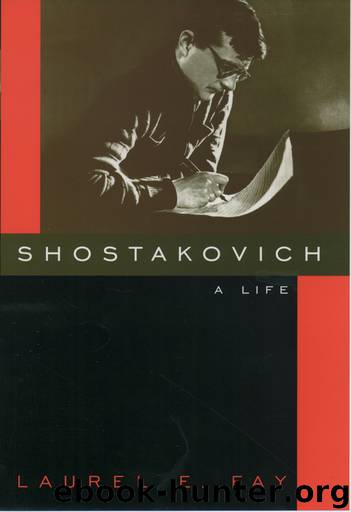Shostakovich by Fay Laurel;

Author:Fay, Laurel;
Language: eng
Format: epub
Publisher: Oxford University Press
Published: 2000-12-07T05:00:00+00:00
14
1966–1969
Jubilees
he new year 1966 got off to a productive start. While reports of his ostensible progress on the opera The Quiet Don continued to appear in the press, Shostakovich quietly finished a new quartet—his Eleventh—in F Minor, op. 122, on 30 January. It was dedicated to the memory of Vasiliy Shirinsky, founding second violinist of the Beethoven Quartet, who had died the previous summer.
On 16 February, Shostakovich wrote Glikman that he had begun work on his Fourteenth Symphony; it gave him an excuse to skip the upcoming Composers’ Union Plenum in Moscow to go to the retreat at Repino to work on it.1 A month later, on 20 March, he told Glikman that he was currently writing his Second Cello Concerto and was in the process of finishing up its first movement.2 That this was one and the same work was clarified in a letter the composer wrote shortly before the concerto’s premiere: “It seems to me that the Second Concerto could have been called the Fourteenth Symphony with a solo cello part.”3 By 9 April, Shostakovich had written three movements but claimed that the third was “very bad” and he had decided therefore to rewrite it from scratch.4 Ten days later, hewent to the Crimea for treatment at a sanatorium near Yalta, and it was there that he completed his new cello concerto on 27 April. What he singled out as the most curious feature in the lengthy three-movement work was the appearance (in the second movement and at the climax of the third) of a theme remarkably similar to the lowly Odessan ditty, “Pretzels, Buy My Pretzels!” but he could not explain what had brought it on.5 Actually, during New Year’s Eve festivities celebrated at Zhukovka with Rostropovich and other neighbors four months earlier, the guests had engaged in a game of “My Favorite Melody,” and while others had chosen melodies by Beethoven, Mozart, and Chaikovsky, Shostakovich had unexpectedly offered this tune, as if in the grip of youthful nostalgia.6
It was Rostropovich’s artistry that was in his mind’s ear as Shostakovich composed the Second Cello Concerto, just as it had been with his First. And, although the appearance of the concerto came as a surprise, this was the one time in Rostropovich’s experience that Shostakovich showed him a work before it was done, perhaps at the moment when he had resolved to rewrite the third movement. Rostropovich was able to offer him a suggestion that subsequently he was delighted to discover the composer had incorporated in the cadenza.7 On its completion, Shostakovich sent the cellist the piano score from the Crimea. Rostropovich learned the concerto straightaway, traveling to Yalta to play it for Shostakovich before his departure in mid-May.
While the composer immersed himself in composition, plans for the widespread commemoration of his sixtieth birthday were unfolding. By this juncture in his career, Shostakovich had achieved the indisputable status of composer laureate. A projected film biography of the composer fell through, but another film, mixing historical footage with contemporary
Download
This site does not store any files on its server. We only index and link to content provided by other sites. Please contact the content providers to delete copyright contents if any and email us, we'll remove relevant links or contents immediately.
The Goal (Off-Campus #4) by Elle Kennedy(13207)
Kathy Andrews Collection by Kathy Andrews(11340)
Diary of a Player by Brad Paisley(7270)
What Does This Button Do? by Bruce Dickinson(5936)
Assassin’s Fate by Robin Hobb(5863)
Big Little Lies by Liane Moriarty(5521)
Altered Sensations by David Pantalony(4872)
Pale Blue Dot by Carl Sagan(4628)
Sticky Fingers by Joe Hagan(3916)
The Death of the Heart by Elizabeth Bowen(3342)
The Heroin Diaries by Nikki Sixx(3326)
Beneath These Shadows by Meghan March(3154)
Confessions of a Video Vixen by Karrine Steffans(3104)
The Help by Kathryn Stockett(3023)
How Music Works by David Byrne(2968)
Jam by Jam (epub)(2881)
Harry Potter 4 - Harry Potter and The Goblet of Fire by J.K.Rowling(2814)
Strange Fascination: David Bowie: The Definitive Story by David Buckley(2703)
Petty: The Biography by Warren Zanes(2575)
